|
Since I
first heard this music (in Karpathos in 1976, then in Crete in 1978, and
again in Karpathos in 1980), I was never able to hear musicians in such
festivals playing without amplification: high quality contact pick-ups
are now used, though the overall sound is usually saturated, due to the
excessive load for the small Italian PA systems, pushed ‘to the red’.
|

(mp3
file)
Sta marmara tou Galata,
a song from Karpathos, performed by group from Olympos,
Karpathos, without amplification
excerpt from recording by Giuliano d’Angiolini, 1994-1995,
Grčce: musique de l’île de Karpathos, Buda Records 92644-2
|

(mp3
file)
Sta marmara tou galata,
as performed by group from Kassos
Panagía Polítissa festival, August 22nd, 1999,
recording by the author
|
|
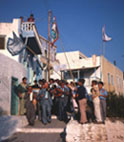
Laouto player with pickup and Fender amplifier at Panagía
Polítissa festival, 1998 |
Wedding in Karpathos, 1980. The lyra player is singing into the
microphone of a portable PA system
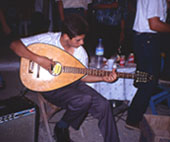
|

Violin player at Panagía Polítissa festival, 2002, with
microphone, mixer, minidisc recorder |
Bass player with Montarbo PA system and electrified lyra at
Panagía Polítissa festival, 1999

|
However,
I have the impression that some harsh, distorted quality in the vocal
and lyra sounds are the result of an aesthetic choice, rather
than just a technical limit. Though my knowledge of the repertory of
these bands is far from being acceptable by ethnomusicological
standards, year after year I was able to recognise many of the most
common pieces or dances. One permanent request (specially at Livadia’s
festival) is for michanikós, the dance of sponge divers from
Kalimnos.
|
For many decades divers using diving suits were exposed to risks
of decompression disease (‘bends’) by bringing them back to
surface without any precaution. Many died, others had their
articulations stiffened, coordination problems, nausea, numbness
(Warn 2000). In the dance, the leader of the line leans on a
stick, and moves as if he had ‘bends’, almost falling to the
floor, held by his neighbours. This is a dramatic point in the
whole night (usually the announcement of the michanikós
causes murmured comments in the crowd), released and transformed
as soon as the music changes pace, allowing the acting diver and
the whole line of dancers to get into a much merrier mood.
|

(mp3
file)
Michanikós Announcement
Banleader announces michanikós:
comments by the audience
Panagía Polítissa festival, August 22nd, 1999,
recording by the author

(mp3
file)
Michanikós
Group from Kassos performs michanikós.
Panagía Polítissa
festival, August 22nd, 1999,
recording by the author
|
|
Dances that all participants seem to know perfectly are
sirtós, sousta, kritikós, hasapikós
servikós. The composition of each dance line varies
according to those who requested the piece, and some numbers
(like Marmara) are clearly better ‘floor fillers’ than
others, but after many years of visits to Tilos and reviewing my
older photographs I’d say that the whole community is there. The young put on their smartest outfits, like going to a disco, and show pride for their ability to dance. Everyone pays respect to the oldest dancers. Though age, gender and class power structures show all their relations, it is amazing to see how they administered in such an organic way. It is the historical role of such events, of course.
|
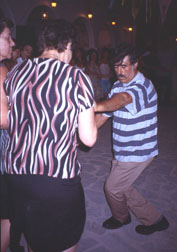 |
|
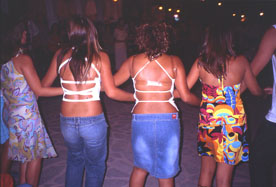 |
Expert dancers at Agios
Pandeleímonas festival, 2004
Young dancers at Agios Pandeleímonas festival, 2004
|
It is even more amazing, then, to notice that exactly the same attitudes, in exactly the same community, are shown at the other major musical events in Tilos,
pop concerts. In 1999, a new open-air theatre (in the classical
form) was inaugurated close to the cave where the fossil dwarf
|
elephants
were discovered. Leaning onto a hill, the theatre is oriented so that the audience can see, behind the stage, Megalo Horió, dominated by the Castle of the Knights of St. John. The opening concert (the 21st of August) was by the singer-songwriter Pandelis Thalassinós, who included the date in his tour that was later documented in a double cd. The cd is titled
Ap’ tin Tilo os ti Thraki, ‘From Tilos to Thrace’, and the reference to Tilos
can be seen as a tribute, but also as an emphatic
|
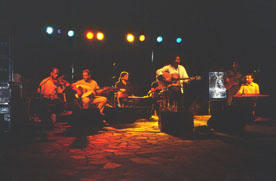
Pandelis Thalassinós and group
at the Dwarf Elephant Cave Theatre, 1999 |
and ironic reminder of
the ubiquity of that tour. Thalassinós was accompanied – as usual with singer-songwriters in the
éndechno genre – by a number of virtuoso professional
performers of various instruments, including drums, bass, keyboards, accordion, violin, electric guitar, but also bouzouki, laouto, outi, lyra, kanonaki, nei, sandouri, doubeleki.

Audience dancing at Pandelis Thalassinós concert, 1999
|
That was the second chance for me that year (after a concert in
a combined tour by Eleni Tsaligopoulou and Melina Kaná, in
Rhodes) to discover the quality and wide popularity of a genre
(or closely related genres) that in my country would have a
quite different audience. After years of traditional groups
performing at festivals with distorted sounds, it was also a
chance to listen to Greek, Ottoman, and Central Asian
instruments in concert with a ‘clean’ sound, that came into the
middle of my thoughts on the contradictory sound aesthetics of
world music (and various folk revivals) on one hand, and of what
seemed to be the existing traditional musics on the other (see
Fabbri 1998, 2001).
|

(mp3
file)
Ta Smyrneika traghoudia
Kanonaki
player performing taximi to introduce Pandelis
Thalassinós
Dwarf Elephant Cave Theatre,
August 21st, 1999,
recording by the author
|
All
concerts at the Dwarf Elephant Cave Theatre are organised by the mayor,
and are of course a political counterpart of the religious festivals.
The mayor’s office kindly sent me a list of all the concerts since 1999,
but the fax came out blurred and I was never able to get another copy,
so the list below is not complete. When an exact date appears, it is
because I attended and recorded the concert:
-
August
21st, 1999 – Pandelis Thalassinós
-
2000 –
Vassilis Papacostandinou
-
August 8th,
2000 – Sokrátis Málamas (for me, one of the world’s best
singer-songwriters, no exaggeration)
-
2001 –
Nikos Papázoglou
-
August
18th, 2001 – Melina Kaná (one of the finest voices in Europe,
working with singer-songwriters, for world music projects [Lafyra,
with Ashkabad, a group from Turkmenistan], and classical composers
[Nikos Mamangákis wrote his Tragoudhia ghia tin Melina])
-
August
11th, 2002 – Milthiádis Paschalidis
-
August
11th, 2003 – Yorgos Zervakis
-
August
20 th, 2003 (attended, but not recorded) – Nikos Portokáloglou
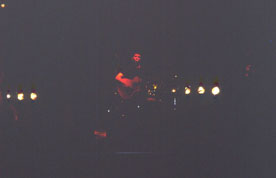
Sokrátis Málamas
at the Dwarf Elephant Cave Theatre, 2000
|

(mp3
file)
Petáo petres
by
Sokrátis Málamas
Dwarf Elephant Cave
Theatre, August 8th, 2000, recording by the author
|
|

(mp3
file)
Opios agápise dhen xeri na to pi
by
Melina Kaná
Dwarf Elephant Cave Theatre, August 18th, 2001,
recording by the author
|

(mp3
file)
Che Guevara
by
Milthiádis Paschalidis
and audience singing along
Dwarf Elephant Cave Theatre, August 11th,
2002, recording by the author
|
|
Though it took place in the neighbouring island of Nissiros, I
should also mention the concert held on August 16th,
2000 by Nikos Papázoglou, not just for its extraordinary
location, the volcano’s crater, but because the Tilians
organised a special ship to move in mass to Nissiros (in the
middle of the season, some
bars and tavernas were closed). Moreover, the |
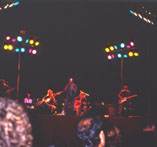 |
Nikos Papázoglou in the volcano, 2000 |
concert had the
same character of most of the ones at the Elephant Cave: very
mixed participation, people of all ages singing along, and the
band playing traditional dances in the last thirty minutes of
the concert.

(mp3
file)
Idrochoos
by
Nikos Papázoglou
Volcano, Nissiros, August 16th,
2000, recording by the author
I do not
mean that in these occasions distinctions become blurred: it is very
clear even for me, an Italian, though a popular music scholar, that
things are different and are perceived differently. But there are also
signs of overlaps, of cloudy intersections (to recall a brilliant
definition of ‘musics’ by Iannis Xenakis) between categories – the
traditional and the popular – that shouldn’t be accepted as separate
without thinking. There were many memorable moments during these
concerts, and it would really take hours just to go through them. Maybe
the latest I recorded would deserve a longer excerpt, because here the
blur between categories becomes dramatic: the ‘star’ is Yorgos Zervákis,
from Crete. He is a great virtuoso of the lyra, playing
electrified violin
|
as well. He plays both, with Jimi Hendrix probably at the back
of his mind. But he isn’t a rockstar: he is one of the best
known followers of the tradition of the mandinades,
improvised poetry (likely of Venetian origin). His performance
lasts over four hours, and he makes people dance, but everyone
follows the
rhymes,
and there is applause when (probably using formulas
or rehearsed tricks, but with apparently inexhaustible energy) Zervákis
gets to the end of an improvised verse with a wit, or a sentence with
moral or religious significance. |

(mp3
file)
Mandinades
by
Yorgos Zervakis
Dwarf Elephant Cave Theatre,
August 11th, 2003,
recording by the author
|
It’s a
lively recording, one of the main differences from attending the real
concert being the fact that, at the end, it wouldn’t be possible to
finish the night at Mikró Chorió Bar.
|









